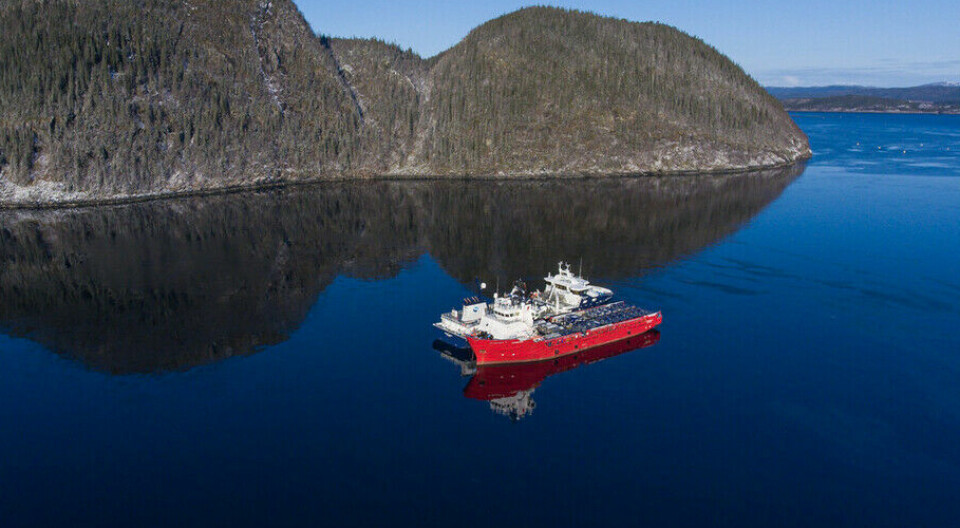
Benchmark offers simpler process in bid to boost Ectosan lice medicine sales
New CleanTreat Integrated system removes need for expensive second vessel
Aquaculture biotech company Benchmark expects to expand opportunities for use of its novel lice treatment Ectosan Vet when it unveils a wellboat-integrated version of its CleanTreat water filtration system at Seafood Expo Global/Seafood Processing Global in Barcelona in next month.
Ectosan must only be used in conjunction with CleanTreat, which removes chemical residue from the treatment water before it is returned to the sea.
But until now the process has required two vessels – a wellboat for delousing the fish and a platform service vessel (PSV) fitted with CleanTreat – which adds expense and limits accessibility. Benchmark operated two CleanTreat PSVs in Norway but decommissioned one due to lack of demand.
The launch of CleanTreat Integrated follows more than a year of collaboration with Norwegian wellboat fish handling expert MMC First Process.
Effective and cost-efficient
“By consolidating the water purification process on to a single vessel, the industry gains easier access to removing medicines from treatment water with minimal environmental impact,” said Benchmark in an announcement on its website. “This advancement promises a more effective, cost-efficient, and flexible use of sea lice medicines, while also paving the way for the cleansing of future medicines and other substances from bath treatments on wellboats.”
No vessels have yet been fitted with CleanTreat Integrated, but MMC First Process will begin offering the system to wellboat owners and salmon companies when it is launched in April.
CleanTreat Integrated is specifically for new-build vessels but a CleanTreat system can be retrofitted on to wellboats or other vessels, explained Birgitte Sørheim, Benchmark’s marketing director for the salmon sector. “We are currently in active discussions with customers regarding this option,” added Sørheim. “When we mention CleanTreat Integrated, we are specifically referring to scenarios where the CleanTreat system is incorporated into the vessel blueprints during the design phase of new builds. Although retrofitting is entirely feasible, it may entail compromises in terms of space or treatment efficiencies, which can be avoided by integrating the system into the vessel from the outset.”
The wellboat company will pay for the system, said Sørheim, with the end customer – the
fish farmer – paying for the medicine.
Faroe Islands
Benchmark has marketing authorisation for Ectosan in both Norway and the Faroes, but the medicine hasn’t been used in the Faroes because biosecurity rules prevent a CleanTreat vessel coming from Norway. CleanTreat Integrated may solve the problem.
“The CleanTreat Integrated system can be implemented on wellboats in the Faroe Islands, facilitating the market penetration of Ectosan Vet,” confirmed Sørheim. “Since the regulatory framework already is established, the Faroese industry can commence medicinal treatments with Ectosan Vet as soon as the system becomes available.”
Chile next
Chile, the world’s second largest salmon producing nation, is likely to be the next country to authorise use of Ectosan Vet, and CleanTreat Integrated or a retrofit version may be used there. A land-based system may also be an option.
Last month, Javier Moya, general manager of Benchmark Animal Health Chile, told Fish Farming Expert’s Chilean sister site, Salmonexpert.cl, that the company is on track to present a dossier to Chile’s Agricultural and Livestock Service (SAG) during the first half of this year.
“In parallel, we are working on CleanTreat configurations for Chile in order to apply the technology, either on a boat or installed on land. And we are in conversations with local producers and supplier companies to find the best way to use this treatment system,” Moya said.
Scotland must wait
Benchmark is not yet seeking authorisation to use Ectosan in the UK, although trials have demonstrated that CleanTreat could also be used to remove more than 90% of Benchmark’s other lice medicine, Salmosan Vet (azamethiphos), and CleanTreat Integrated may benefit Scottish salmon farmers over time.
Salmosan has a UK licence and is currently applied in tarpaulin bath treatments, but its use is severely limited by the capacity of water bodies to absorb medicine residues without harm to fauna. Treating salmon for lice with Salmosan aboard a wellboat and then filtering the treatment water would massively increase treatment capacity without breaching discharge limits.
But Scotland is not at the front of the queue.
“We anticipate that it will take several years to prepare and make available a wellboat with CleanTreat Integrated for the UK market,” said Sørheim. “Therefore, we do not expect to use the system for Salmosan Vet in the near future. However, if there is interest from the market, it could be possible to use the new system for Salmosan Vet. This also applies to any potential new medicines developed in the future.
“In the UK, farmers need consent for the emissions of medicines per site. Due to this regulation, in many cases, it is not practical to use Salmosan Vet without a CleanTreat system for purifying the treatment water. This is also the case in Canada, specifically BC, where it is currently not permitted to use medicines to protect wildlife. With CleanTreat Integrated, this issue may be resolved for this region as well.”






















































